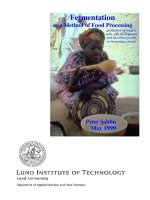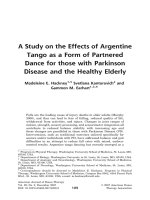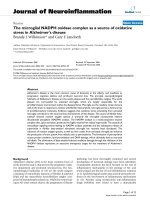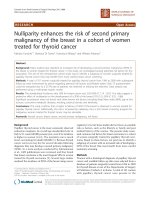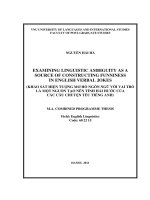Brown algae as a source of bioactive compounds for pancreatic cancer treatment
Bạn đang xem bản rút gọn của tài liệu. Xem và tải ngay bản đầy đủ của tài liệu tại đây (7.14 MB, 247 trang )
Brown algae as a source of bioactive
compounds for pancreatic cancer treatment
Thanh Trung Dang
B.Eng (Nha Trang University, Khanh Hoa, Vietnam)
MSc (Nha Trang University, Khanh Hoa, Vietnam)
A thesis submitted in fulfilment of the requirements for the degree of
Doctor of Philosophy in Food Science
School of Environmental and Life Sciences, Faculty of Science
University of Newcastle Australia
May 2018
STATEMENT OF ORIGINALITY
I hereby certify that to the best of my knowledge and belief this thesis is my own work and
contains no material previously published or written by another person except where due
references and acknowledgements are made. It contains no material which has been previously
submitted by me for the award of any other degree or diploma in any university or other
tertiary institution.
Thanh Trung Dang
Date: 6/5/2018
i
DECLARATION OF AUTHORSHIP
I hereby certify that this thesis is in the form of a series of 8 papers. I have included as part of
the thesis a written statement from each co-author, endorsed in writing by the Faculty
Assistant Dean (Research Training), attesting to my contribution to any jointly authored
papers.
Thanh Trung Dang
Date: 6/5/2018
ii
ACKNOWLEDGEMENTS
Firstly, I would like to give a great appreciation to my supervisors: Principal supervisor:
A/Prof. Christopher J. Scarlett; Co-supervisors: A/Prof. Michael C. Bowyer and Dr. Ian A. Van
Altena for their supervision and support during my PhD course. The suggestions and
encouragement from the supervisor panel played an important role in my research
achievements.
I acknowledge the financial support from University of Newcastle; the Vietnamese
Government through the Ministry of Education and Training; the Ministry of Agriculture and
Rural Development for awarding a VIED-TUIT scholarship, which enabled me to study for a
PhD at the University of Newcastle, with full cover for academic expenses, as well as living
and travellingallowances.
I highly appreciated the contribution of brown algae as the material for my PhD project from
Dr. Maria Schreider (School of Environmental and Life Sciences, Faculty of Science,
University of Newcastle), in particular for identifying algal species and allowing her students
assist in the collection of the samples.
I would like to say thank you to Dr. Quan V. Vuong, Dr. Danielle Bond and other PhD students
in Food Science, technical staff and administrative staff for helping me to overcome the
difficulties in the laboratory and administrative works.
Finally, I would like to say thank my colleagues and friends from Nha Trang University,
Vietnam for their encouragement. A very special thank you is given to my family (parents,
young brother), who have always been behind me, encouraging and inspiring me during my
PhD project.
iii
LIST OF PUBLICATIONS INCLUDED AS PART OF THE THESIS
I warrant that I have obtained, where necessary, permission from the copyright owners to use
any third party copyright material reproduced in the thesis, or to use any of my own published
work in which the copyright is held by another party.
1.
Paper I: Dang TT, Vuong QV, Schreider MJ, Bowyer MC, Van Altena IA & Scarlett CJ.
(2017). The Effects of Drying on Physico‐Chemical Properties and Antioxidant Capacity of the
Brown Alga (Hormosira banksii (Turner) Decaisne). J. Food Process Pres 41(4): e13025.
doi.org/10.1111/jfpp.13025.
2.
Paper II: Dang TT, Bowyer MC, Van Altena IA & Scarlett CJ. (2018). Comparison of
chemical profile and antioxidant properties of the brown algae, Inter. Food Sci. Technol 51(1):
174-181. doi: 10.1111/ijfs.13571.
3.
Paper III: Dang TT, Vuong QV, Schreider MJ, Bowyer MC, Van Altena IA & Scarlett
CJ (2017). Optimisation of ultrasound-assisted extraction conditions for phenolic content and
antioxidant activities of the alga Hormosira banksii using response surface methodology. J
Appl Phycol 29(6): 3161-3173. doi.org/10.1007/s10811-017-1162-y.
4.
Paper IV: Dang TT, Bowyer MC, Van Altena IA & Scarlett CJ. (2017). Optimum
conditions of microwave assisted extraction for phenolic compounds and antioxidant capacity
of
the
brown
alga
Sargassum
vestitum.
Sep
Sci
Technol
(In
Press).
doi.org/10.1080/01496395.2017.1414845.
5.
Paper V: Dang TT, Vuong QV, Bowyer MC & Scarlett CJ. Chemical profile and
antioxidant activities of the crude extract and different fractions prepared from the brown alga
Hormosira banksii (Turner) Decaisne. Submitted to Journal of Botanica Marina.
6.
Paper VI: Dang TT, Bhuyan DJ, Bond DR, Bowyer MC, Van Altena IA & Scarlett CJ.
iv
Fucoxanthin content, isolation and cytotoxic activity against pancreatic cancer from brown alga
Hormosira banksii (Turner) Decaisne. Submitted to Journal of Biotechnology.
7.
Paper VII: Dang TT, Sakoff JA, Bowyer MC, Van Altena IA & Scarlett CJ. Antioxidant
and cytotoxic activity (in vitro) of phlorotannin-enriched fractions from the brown alga
Hormosira banksii (Turner) Decaisne. Submitted to Journal of MarineBiotechnology.
8.
Paper VIII: Dang TT & Scarlett CJ. Extraction and cytotoxic activity of the sulfated
polysaccharides (fucoidans) against pancreatic cancer in vitro from brown alga Hormosira
banksii (Turner) Decaisne. Submitted to Journal of Biomedicine andPharmacotherapy.
v
STATEMENT OF AUTHORS' CONTRIBUTION TO THE PAPERS
To whom it may concern,
We, Quan V. Vuong, Maria J. Schreider, Christopher J. Scarlett, Michael C. Bowyer and
Ian A. Van Altena as co-authors with contribution of planning, giving the suggestions and
editing the paper, attest that research higher degree candidate, Thanh Trung Dang, was the
principle contributor to the planning, execution, analyses of the experiments and the
writing of the published research paper entitled “The Effects of Drying on Physico‐Chemical
Properties and Antioxidant Capacity of the Brown Alga (Hormosira banksii (Turner)
Decaisne)”. J. Food Process Pres 41(4): e13025. doi.org/10.1111/jfpp.13025.
Dr. Ian A. Van Altena
Date: 27/4/2018
Thanh Trung Dang
Date: 26/4/2018
I have seen this paper and I agree with the signatories above that it represents a substantial
amount of research work and can be part of Thanh Trung Dang’ s PhD thesis.
Professor Frances Martin
Assistant Dean Research Training (ADRT)
Date:
ix
STATEMENT OF AUTHORS' CONTRIBUTION TO THE PAPERS
To whom it may concern,
We, Christopher J. Scarlett, Michael C. Bowyer and Ian A. Van Altena as co-authors with
contribution of planning, giving the giving the suggestions and editing the paper, attest that
research higher degree candidate, Thanh Trung Dang, was the principle contributor to the
planning, execution, analyses of the experiments and the writing of the published research
paper entitled “Comparisonof chemical profileandantioxidantproperties of the brown algae”,
Inter. Food Sci. Technol 51(1): 174-181. doi:10.1111/ijfs.13571.
Dr. Ian A. Van Altena
Date: 27/4/2018
Thanh Trung Dang
Date: 26/4/2018
I have seen this paper and I agree with the signatories above that it represents a substantial
amount of research work and can be part of Thanh Trung Dang’ s PhD thesis.
Professor Frances Martin
Assistant Dean Research Training (ADRT)
Date:
x
STATEMENT OF AUTHORS' CONTRIBUTION TO THE PAPERS
To whom it may concern,
We, Quan V. Vuong, Maria J. Schreider, Christopher J. Scarlett, Michael C. Bowyer and
Ian A. Van Altena as co-authors with contribution of planning, giving the giving the
suggestions and editing the paper, attest that research higher degree candidate, Thanh
Trung Dang, was the principle contributor to the planning, execution, analyses of the
experiments and the writing of the published research paper entitled “Optimisation of
ultrasound-assisted extraction conditions for phenolic content and antioxidant activities of the
alga Hormosira banksii using response surface methodology”. J Appl Phycol 29(6): 31613173. doi.org/10.1007/s10811-017-1162-y.
Dr. Ian A. Van Altena
Date: 27/4/2018
Thanh Trung Dang
Date: 26/4/2018
I have seen this paper and I agree with the signatories above that it represents a substantial
amount of research work and can be part of Thanh Trung Dang’ s PhD thesis.
Professor Frances Martin
Assistant Dean Research Training (ADRT)
Date:
xi
STATEMENT OF AUTHORS' CONTRIBUTION TO THE PAPERS
To whom it may concern,
We, Christopher J. Scarlett, Michael C. Bowyer and Ian A. Van Altena as co-authors with
contribution of planning, giving the feedbacks and editing the paper, attest that research higher
degree candidate, Thanh Trung Dang, was the principle contributor to the planning, execution,
analyses of the experiments and the writing of the published research paper entitled “Optimum
conditions of microwave assisted extraction for phenolic compounds and antioxidant capacity
of
the
brown
alga
Sargassum
vestitum”
Sep
Sci
Technol
(In
Press).
doi.org/10.1080/01496395.2017.1414845.
Dr. Ian A. Van Altena
Date: 27/4/2018
Thanh Trung Dang
Date: 26/4/2018
I have seen this paper and I agree with the signatories above that it represents a substantial
amount of research work and can be part of Thanh Trung Dang’ s PhD thesis.
Professor Frances Martin
Assistant Dean Research Training (ADRT)
Date:
xii
STATEMENT OF AUTHORS' CONTRIBUTION TO THE PAPERS
To whom it may concern,
We, Quan V. Vuong, Christopher J. Scarlett, Michael C. Bowyer as co-authors with
contribution of planning, giving the suggestions and editing the paper, attest that research
higher degree candidate, Thanh Trung Dang, was the principle contributor to the planning,
execution, analyses of the experiments and the writing of the published research paper
entitled “Chemical profile and antioxidant activities of the crude extract and different fractions
prepared from the brown alga Hormosira banksii (Turner) Decaisne”. Submitted to Journal of
Botanica Marina.
Thanh Trung Dang
Date: 26/4/2018
I have seen this paper and I agree with the signatories above that it represents a substantial amount
of research work and can be part of Thanh Trung Dang’ s PhD thesis.
Professor Frances Martin
Assistant Dean Research Training (ADRT)
Date:
xiii
STATEMENT OF AUTHORS' CONTRIBUTION TO THE PAPERS
To whom it may concern,
We, Deep J. Bhuyan, Danielle R. Bond, Christopher J. Scarlett, Michael C. Bowyer and Ian
A. Van Altena as co-authors with contribution of planning, giving the giving the
suggestions and editing the paper, attest that research higher degree candidate, Thanh
Trung Dang, was the principle contributor to the planning, execution, analyses of the
experiments and the writing of the published research paper entitled “Fucoxanthin content,
isolation and cytotoxic activity against pancreatic cancer from brown alga Hormosira banksii
(Turner) Decaisne”. Submitted to Journal Biotechnology.
Dr. Ian A. Van Altena
Date: 27/4/2018
Thanh Trung Dang
Date: 26/4/2018
I have seen this paper and I agree with the signatories above that it represents a substantial amount
of research work and can be part of Thanh Trung Dang’ s PhD thesis.
Professor Frances Martin
Assistant Dean Research Training (ADRT)
Date:
xiv
STATEMENT OF AUTHORS' CONTRIBUTION TO THE PAPERS
To whom it may concern,
We, Christopher J. Scarlett, Jennette Sakoff, Michael C. Bowyer and Ian A. Van Altena as
co-authors with contribution of planning, giving the suggestions and editing the paper and
Jennette Sakoff (conducting experiments of cancer cells), attest that research higher degree
candidate, Thanh Trung Dang, was the principle contributor to the planning, execution,
analyses of the experiments and the writing of the research paper entitled “Antioxidant and
cytotoxic activity (in vitro) of phlorotannin-enriched fractions from the brown alga Hormosira
banksii (Turner) Decaisne”. Submitted to Journal of Marine Biotechnology.
Dr. Ian A. Van Altena
Date: 27/4/2018
Thanh Trung Dang
Date: 26/4/2018
I have seen this paper and I agree with the signatories above that it represents a substantial
amount of research work and can be part of Thanh Trung Dang’ s PhD thesis.
Professor Frances Martin
Assistant Dean Research Training (ADRT)
Date:
xv
STATEMENT OF AUTHORS' CONTRIBUTION TO THE PAPERS
To whom it may concern,
Christopher J. Scarlett as co-authors with contribution of planning, giving the suggestions
and editing the paper, attest that research higher degree candidate, Thanh Trung Dang, was
the principle contributor to the planning, execution, analyses of the experiments and the
writing of the research paper entitled “Extraction and cytotoxic activity of the sulfated
polysaccharides (fucoidans) against pancreatic cancer in vitro from brown alga Hormosira
banksii (Turner) Decaisne. Submitted to Journal of Biomedicine and Pharmacotherapy.
Thanh Trung Dang
Date: 26/4/2018
I have seen this paper and I agree with the signatories above that it represents a substantial
amount of research work and can be part of Thanh Trung Dang’ s PhD thesis.
Professor Frances Martin
Assistant Dean Research Training (ADRT)
Date:
xvi
CONFERENCE PRESENTATIONS
1. Thanh T. Dang, Quan V. Vuong, Micheal C. Bowyer, Ian A. Van Altena, Christopher J.
Scarlett. Phytochemical and antioxidant properties of crude and fractionated extracts from
the brown alga Hormosira banksii (Turner) Decaisne. International scientific conference
“Sustainable Agriculture and Environment” December, 13-14, 2016, Ho Chi Minh City,
Vietnam. Oral presentation.
2. Thanh T. Dang, Quan V. Vuong, Maria J. Schreider, Micheal C. Bowyer, Ian A. Van
Altena, Christopher J. Scarlett. Effect of drying methods on chemical properties and
antioxidant capacity of the brown alga (Hormosira banksii). 3rd International Conference
Sustainable Agriculture, Food and Energy November, 17-20, 2015, Ho Chi Minh City,
Vietnam. Oral presentation.
xiv
LIST OF ABBREVIATIONS
°
C
µL
ANOVA
AQ
BuOH
DCM
EA
et al.
g
Hx
h
MAE
min
mL
Mw
nM
RP-HPLC
RSM
sec
TFC
TLC
TPC
UAE
UV-Vis
v/v
w/v
w/w
W
Degree Celsius
Microliter (s)
Analysis of Variance
Aqueous fraction
Butanol fraction
Dichloromethane fraction
Ethyl acetate fraction
and others
gram (s)
Hexane fraction
hour( s)
Microwave Assisted Extraction
Minute (s)
Millilitre (s)
Molecular weight
Nano-moles
Reversed-phase High Performance Liquid Chromatography
Response Surface Methodology
Second (s)
Total Flavonoid Content
Thin Layer Chromatography
Total Phenolic Content
Ultrasonic Assisted Extraction
Ultraviolet- Visible
Volume by Volume
Weight by Volume
Weight by Weight
Watt (s)
xv
FIGURES FOR THESIS
Figure 1: Stran-fucoxanthin
Figure 2: Some phlorotannins with phloroglucinol (1,3,5-trihydroxybenzene) as a basic unit
xvi
Figure 2: Some phlorotannins with phloroglucinol as a basic unit (continue)
Structure of fucoidan unit
Figure 3: Sulfated polysaccharides (Fucoidans)
xvii
TABLE OF CONTENTS
STATEMENT OF ORIGINALITY --------------------------------------------------------------- i
DECLATATION OF AUTHORSHIP ------------------------------------------------------------ ii
ACKNOWLEDGEMENTS------------------------------------------------------------------------ iii
LIST OF PUBLICATIONS INCLUDED AS PART OFTHE THESIS ---------------------- iv
STATEMENTS OF AUTHOR S’ CONTRIBUTION TOTHE PAPERS ------------------- vi
CONFERENCE PRESENTATIONS ------------------------------------------------------------ xiv
LIST OF ABBREVIATIONS -------------------------------------------------------------------- xv
FIGURES FOR THE THESIS-------------------------------------------------------------------- xvi
TABLE OF CONTENTS ----------------------------------------------------------------------- xviii
ABSTRACT ----------------------------------------------------------------------------------------- xx
1
PART 1: LITERATURE REVIEW
1.1
1.1.1
a)
b)
1.1.2
a)
b)
c)
d)
1.1.3
a)
b)
1.1.4
a)
b)
1.1.5
1.1.6
a)
b)
Background
1
Algae and health benefits
Overview of marine algae
Health benefits
Bioactive compounds from brown algae
Fucoxanthin
Pholorotannins
Polysaccharides (fucoidans)
Other components
Extraction of algal compounds
Microwave Assisted Extraction
Ultrasound Assisted Extraction
Isolation and identification of bioactive compounds
Chromatographic separation and isolation ofbioactive compounds
Identification of bioactive compounds
Activities of algal compounds against several cancer cell lines
Algal components against pancreatic cancer cell lines
Problems with pancreatic cancer
Algal compounds against pancreatic cancer
1
1
2
4
4
5
6
7
8
9
10
10
10
15
16
18
18
19
1.2
Research content
20
1.3
Research Aims and Expected Outcomes
21
1.4
Experimental Rationale
21
1.5
Hypothesis, aims and objectives
23
26
PART 2: RESULTS
2.1
Synopsis of research papers published from results
26
2.2
Research papers published from results
32
xviii
PART 3: GENERAL DISCUSSION AND CONCLUSIONS
3.1
3.1.1
3.1.2
3.1.3
3.2
3.2.1
3.2.2
General discussion
34
34
Preparation of the samples (dryingand extraction)
Bioactive compounds and isolation processes frombrown algae
Activity of algal compounds against pancreatic cancercell lines
Conclusions and recommendations
35
38
41
43
Conclusions
Recommendations
43
45
46
BIBLIOGRAPHY
xix
ABSTRACT
Marine macro-algae (seaweeds) are a rich source of bioactive compounds that have the
potential to be used as functional constituents for human health applications. Bioactive
compounds from brown algae include pigments, sulfated polysaccharides (fucoidans),
phlorotannins (marine phenolics), terpenes and other secondary metabolites. These compounds
have been reported to possess biological activity against a range of chronic diseases, including
cancer.
Pancreatic cancer has a high mortality rate and short survival timeline due to difficulties
associated with achieving a correct diagnosis at an early stage of the disease, a predisposition
to metastasise to other organs within the body, and a lack of progress in the development of
new therapeutic strategies. For decades, gemcitabine has remained the single front-line
chemotherapeutic agent for treating advanced adenocarcinoma of the pancreas. A low
proportion of patients however see direct and meaningful benefit from gemcitabine, with
current combinatorial chemo-radiation treatment regimens delivering only limited survival
benefits.
Brown algae Sargassum vestitum; Sargassum linearifolium; Phyllospora comosa; Padina sp.;
Hormosira banksii and Sargassum podocanthum are species found in Eastern Coast of NSW,
Australia. Despite their relative abundance, knowledge of the phytochemical properties of
extracts from these species remains limited. Therefore, an assessment of the bioactive potential
of compounds derived from these brown algae against pancreatic cancer is justified.
The current study hypothesised that the physico-chemical profile and antioxidant activities of
bioactive compounds derived from brown algae could be improved through optimisation of
drying and extraction conditions, and that phytochemical fractions or individual compounds
isolated from the algae display efficacy against pancreatic cancer cell lines.
xx
The overall aims were to:
•
Optimise drying conditions for algae to preserve chemical activity and antioxidant
power.
•
Optimise the extraction of phenolics from algae using irradiative technologies such as
ultrasound and microwave.
•
Isolate key components including fucoxanthin, phenolics and polysaccharides for
assessment of their cytotoxic activity against a range of pancreatic cancer celllines.
Six drying methods were applied to H. banksii samples including de-humidification, vacuum
and freeze drying, sun drying (in direct sunlight), as well as microwave and oven drying. The
temperature of 50 °C was found to be optimal for both de-humiditification and vacuum oven
drying, while sun drying produced the highest bioactive compound yield and was the most cost
effective.
Among the six algal extracts, H. banksii possessed the highest total phenolic content (TPC)
with 158.82 mg GAE.g-1 followed by S. vestitum and Padina sp. (141.91 and 124.65 mg
GAE.g-1, respectively). Total flavonoid content (TFC) was highest in H. banksii (29.31 CAE.g1
), while Padina sp. produced the highest tannin content (56.17 mg CAE.g-1). Fucoxanthin
content was present in all six extracts, with four species - Padina sp.; S. linearifolium; S.
vestitum and S. podocanthum possessing with high concentrations (1.97; 1.76; 1.65 and 1.46
mg fucoxanthin.g-1) respectively.
Extraction of phenolics from H. banksii using aqueous ethanol (70%) and ultrasonic irradiation
improved both total yield and antioxidant activity. Optimal extraction conditions were
determined to be; temperature = 30 °C, extraction time = 60 min., irradiation power = 60%
(150w). The highest values of TPC and antioxidant activity (ABTS, DPPH and FRAP)
achieved were 23.12 mg GAE.g-1, 85.64 TE.g-1, 47.24 TE.g-1 and 12.56 TE.g-1, respectively.
xxi
Microwave-assisted extraction was applied to extract phenolics from S. vestitum using aqueous
ethanol 70% as a solvent. From the preliminary experiments and literature, acetone was proved
to be the best solvent in relation to yields of phenolics and produced the highest antioxidant
activity compared to methanol, water and ethyl acetate. However, ethanol was preferred on
safety grounds for usage as well as minimal solvent residue in the sample. Therefore, ethanol
70% is suitable for extraction of phenolics from S. vestitum. The maximal values of TPC and
antioxidant activities gained from this alga were 58.2 mg GAE.g-1, 149.84 TE.g-1, 116.54 TE.g1
and 67.95 TE.g-1, respectively with the optimal conditions determined to be irradiation time
of 75 seconds, ethanol percentage of 70% and power of 80% (1080w).
Polysaccharides from H.banksii were extracted using water and separated by precipitation
using pure ethanol and centrifugation. Sulfated polysaccharides (fucoidans) were observed in
three fractions (CF50, CF70 and CFR). Antioxidant activities of the CF50 and CF70 fractions
were low, while high activity was observed in the CFR fraction due to the presence of high
concentrations of phenolics.
Finally, from the H.banksii extract, fucoxanthin was isolated through solvent partitioning and
column chromatography techniques, in high purity (92.3%; validated by HPLC). Phenolic
compounds were separated in solvent fractions of differing polarity (hexane, dichloromethane,
ethyl acetate and butanol fractions), with ethyl acetate possessing the highest TPC value and
antioxidant activities. Sulfated polysaccharides (fucoidan) with higher sulfate content were
found in the CF70 fraction. Fucoxanthin, phenolic and polysaccharide fractions were
investigated for cytotoxic activity against a range of pancreatic cancer cell lines. With a range
of concentrations (25 – 200 ng.mL-1), phenolic compounds possessing medium polarity (ethyl
acetate fraction) showed excellent cancer cell growth inhibition properties (70-100%) against
Mia PaCa-2, BxPC-3 and CFPAC-1 cell lines but was also toxic towards normal pancreas cells
(HPDE). It was noted that polar phenolic compounds (butanol fraction) exhibited
xxi
xxii
high
cytotoxic activity against these cancer cells but low toxicity against non-tumorigenic cells.
Fucoxanthin was also a potent agent against pancreatic cancer cell lines with high growth
inhibition (inhibition of 30.91–92.81% at concentrations of 100–200 µg.mL-1). Polysaccharides
fractions (CF50 and CF70) showed quite high activity (inhibition of 39.35 – 82.82% at the
concentrations of 100–200 µg.mL-1) against these cancer cells with low toxicity towards
normal cells (IC50 values were 526.32 µg.mL-1 (CF50) and 781.25 µg.mL-1 (CF70)).
In summary, the hypothesis was supported and the aims were achieved in these studies. Three
out of six drying methods were found to be effective for producing higher yields of phenolics
and stronger antioxidant activities. The bioactive components extracted using ultrasound and
microwave techniques were optimised for high efficacy of phenolics and antioxidant activities.
In addition, purified fucoxanthin and polar phenolics obtained by partition and column
chromatography showed strong potential against pancreatic cancer cell lines. Sulfated
polysaccharide fractions (CF50 and CF70) exhibited high cytotoxic effects against pancreatic
cancer cell lines with less toxicity to non-tumorigenic cells. These algal components have
potential application in the functional food and pharmaceutical industries.
xx
xxiii
PART 1: LITERATURE REVIEW
1.1 Background
1.1.1 Algae and health benefits
a) Overview of marine algae
Marine algae are one of the largest biomass producers in the marine environment. Algae, by
definition, do not possess true roots or stems. They are found in all corners of the globe and
occur in a range of sizes and morphologies. Algae are classified into two major sub-groups
based on size; macro-algae and micro-algae (Bocanegra et al., 2009). Micro-algae are
microscopic
organisms
and
include
blue-green
algae
(Cyanobateria),
diatoms
(Bacillariophyta) and dinoflagellates (Dinophyceae) (Garson, 1989). Macro-algae
(seaweeds) are divided into three types; brown algae (Phaeophyceae), red algae
(Rhodophyceae) and green algae (Chlorophyceae). In macro-algae, pigments and their
phytochemical profile are the most common features used in algal classification. In brown
algae, fucoxanthin is the major pigment, while the predominant polysaccharides including
alginates, laminarins, fucans and celluloses. In green algae, chlorophyll a and b are the
dominant pigments, with ulvan being the major polysaccharide component, while coloration
in red algae is derived from the presence of two pigment-protein complexes-phycoerythrin
and phycocyanin (Bocanegra et al., 2009; O’Sullivan et al., 2010).
Macro-algae are a source of biologically active phytochemicals including carotenoids,
polyphenols, polysaccharides, polyunsaturated fatty acids and lipids. They are also an
excellent source of vitamins such as A, B1, B12, C, D and E, riboflavin, niacin, pantothenic
acid and folic acid, as well as minerals such as Ca, P, Na, K (Gupta & Abu-Ghannam,
2011). These compounds are known to possess biological activities and hence have potential
1




